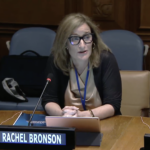The threat of emerging ocean diseases
By Laura H. Kahn | February 18, 2009
Much attention has been paid to newly emergent diseases that have afflicted humans in recent decades–HIV/AIDS, SARS, avian influenza, etc. Conversely, deadly diseases that have emerged in the world’s oceans during the same time period have been largely ignored. While these diseases haven’t caused epidemics in humans, they have proved troublesome to marine animal populations and to susceptible humans who have ventured into contaminated waters. Therefore, we should pay closer attention to what’s happening in the world’s oceans since it could be an important sentinel for global environmental health.
Take for instance, recent epizootics (epidemics in animals) of Atlantic Ocean bottlenose dolphins and endangered Florida manatees. They perished because of the neurotoxins produced by Karenia brevis, a marine plankton that lives year-round in the Gulf of Mexico. (See “Emerging Diseases in Marine Mammals: From Dolphins to Manatees.”)
A single-celled organism (called a dinoflagellate), K. brevis has two whip-like appendages, or flagella, it uses to swim through the water. The neurotoxins produced by K. brevis can kill fish and birds, as well as marine animals.
President Barack Obama has indicated that he’s serious about improving the environment. But we need to make sure that both terrestrial and ocean environments are given equal priority.”
When they become aerosolized in sea spray and inhaled by humans, these organisms can cause people to develop respiratory and eye irritations. The toxins can also accumulate in shellfish such as clams, coquinas, and oysters, causing food poisoning in those who eat them. Symptoms usually begin a few hours after ingestion and include tingling and numbness in the tongue, lips, throat, arms, and legs and dizziness, nausea, and diarrhea. The symptoms usually go away after a few days.
Red tides–gigantic masses of seawater microorganisms such as K. brevis–aren’t limited to Florida’s coastal waters. For example, in 1995, a massive red tide stretched for 500 miles off the coast of California, and three years later, a red tide killed more than 50 sea lions in Monterey Bay, about 120 miles south of San Francisco. (See “Studies Bring New Data to Mystery of Red Tides.”) In addition, there’s evidence that other dinoflagellate species are expanding their range off of the Australian and Tasmanian coasts and in the Mediterranean Sea. Severe hurricanes can expand their distribution, and hurricanes and coral bleaching increase the risk of ciguatera fish poisoning, which, once rare, is now reaching epidemic levels–especially in French Polynesia.
Some have theorized that global warming has contributed to the problem. It makes sense: K. brevis prefers warm waters, so theoretically, global warming and rising ocean temperatures could contribute to the growth in red tides. The fertilizer industry’s dumping of nitrogen waste into the ocean could be another potential cause.
Gambierdiscus toxicus, also a marine microorganism, produces neurotoxins that produce symptoms similar to those caused by K. brevis. But unlike the K. brevis toxin–the symptoms of which usually last for a few days–the symptoms from the G. toxicus toxin can sometimes last for years.
Shewanella algae and Shewanella putrefaciens are two other marine microorganisms commonly found in warm ocean waters. Both have been reported with increasing frequency as causing serious infections in humans. The infections typically involve ear, skin, and soft tissues. And if these organisms get into the bloodstream, the infection can turn deadly. Immunocompromised individuals–particularly those with chronic liver disease–and people with chronic leg ulcers are at increased risk for bloodstream infections, commonly referred to as sepsis. (See “Shewanella Soft Tissue Infection: Case Report and Literature Review.”)
In a specific case study conducted by a hospital in Denmark, two people with chronic lower leg ulcers developed Shewanella alga bacteremia (aka bloodstream infections) after going into the ocean during a very warm summer. Both survived but one suffered from extensive death of muscle tissues.
Healthy children also seem at high risk. For example, another study conducted by a different Danish hospital found that during an unusually warm summer in 1994, 67 people (70 percent of whom were children between the ages of 3 and 15) developed ear infections after swimming or bathing in the ocean.
More recently, at a February New Jersey Chapter of American College Physicians meeting, physicians from a New Jersey hospital reported Shewanella algae sepsis in a 64-year-old man who suffered from a traumatic near-drowning in Delaware Bay, which borders both New Jersey and Delaware. It’s not surprising then that Shewanella species were identified for the first time in shellfish and seawater in Delaware Bay last year. (See “Shewanella and Photobacterium Spp. in Oysters and Seawater from the Delaware Bay.”)
The good news is that much can be done to slow the emergence of new ocean diseases. Already, a number of federally funded programs in Florida such as Ecology and Oceanography of Harmful Algal Blooms and the Harmful Algal Blooms Observing System collect data and monitor the biology of ocean waters in response to environmental variables such as temperature, salinity, and currents. Obviously, these programs should continue to be supported and broadened so all coastal waters are monitored for the presence of harmful microorganisms.
A second, much larger step would be to curtail the human activities that experts believe help some ocean diseases proliferate so quickly–namely, prohibiting the dumping of waste into coastal waters and limiting the amount of greenhouse gases released into the atmosphere.
President Barack Obama has indicated that he’s serious about improving the environment. But we need to make sure that both terrestrial and ocean environments are given equal priority. After all, life began in the ocean, we don’t want it to end there.
Together, we make the world safer.
The Bulletin elevates expert voices above the noise. But as an independent nonprofit organization, our operations depend on the support of readers like you. Help us continue to deliver quality journalism that holds leaders accountable. Your support of our work at any level is important. In return, we promise our coverage will be understandable, influential, vigilant, solution-oriented, and fair-minded. Together we can make a difference.
Topics: Biosecurity, Columnists















